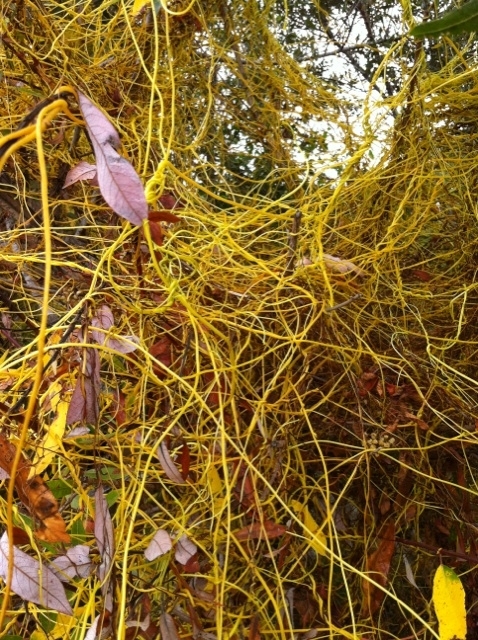Posts Tagged: fruit fly
Japanese dodder found in Santa Barbara County
Olive fruit fly back
Julie Johnson, Orland Press-Register
There are considerably more olive fruit flies this year than at this time last year, said Bill Krueger, UC Cooperative Extension farm advisor for Tehama and Glenn counties. "When it comes to the olive fruit fly we really don't understand everything we need to know, and this is just one example," he said.
Nonpareils' arrival marks start of big almond harvest
Tim Hearden, Capital Press
Nonpareil almonds have been coming out of the orchards in California, ushering in the harvest of what's expected to be a record 1.95 billion-pound almond crop this year. Hullers and shellers in the San Joaquin Valley got their first loads on Aug. 19. "I think all of our orchards look pretty good," said Rick Buchner, a University of California Cooperative Extension farm advisor. "It's a good crop, really clean."
USDA provides funds for California specialty crops research
The USDA issued a news release on Friday announcing $55 million in block grants to enhance the competitiveness of specialty crops around the country, with California receiving more than $17 million. Of the 64 California projects, 19 are led by researchers affiliated with UC Agriculture and Natural Resources.
A large share of funding - $1.4 million - goes to nine food-safety projects to be coordinated by UC’s Center for Produce Safety, according to an article in the Fresno Bee.
"Scientists and researchers with the University of California and industry groups are exploring everything from whether frogs and lizards are potential carriers of E.coli to whether dust from a cattle operation can carry E.coli into a vegetable field," wrote Bee reporter Robert Rodriguez.
The executive director of the Center for Produce Safety, Bonnie Fernandez, told Rodriguez the funding comes at a time of heightened awareness of food safety among consumers and farmers.
"There are simply a lot of unanswered gaps of knowledge on these issues," Fernandez was quoted. "We want to know where the pathogens came from, how it attaches to a product and how we can reduce the risk of that happening."
Management of exotic pests is another issue where USDA provided funding for UC research, according to the listing on USDA's website. For example, grants will support efforts to:
- Release and evaluate four exotic olive fruit fly parasitoids in order to improve sustainable table and oil olive management
- Test the area-wide application of mating disruption of vine mealybug in Napa County
- Evaluate the efficacy of organic pesticides for Asian Citrus Psyllid control so science-based control recommendations can be made to organic citrus growers
- Survey resistance ratios in olive fruit fly populations from California regions not sampled in a previous study
Funds were also made available to expand and improve the online specialty crop production information now available on UC's Fruit & Nut Research and Information Center website and call-in center.
In addition, the new funding will allow UC researchers to work with several school districts and their regional partners to expand their procurement of local seasonal fresh produce, enhance their ability to integrate a specialty crop nutritional curriculum by providing outreach and professional development to school personnel, and assess changes in food preferences and dietary behaviors of children in participating school.
Other UC projects receiving the funding will look into onion seed production, strawberries' ability to restore impaired insulin, steam injection for soil disinfestation, and mealy plum aphid and leaf-curl plum aphid control in prunes.

The UC Center for Produce Safety to receive substantial research funds from USDA.
Melon fruit fly found in Kern County
Farmers and ag officials will gather at the UC Cooperative Extension office in Kern County at 6 p.m. Wednesday to discuss the recent discovery of five melon fruit flies southeast of Bakersfield, according to an article in Western Farm Press.A native of Asia, melon fruit flies' only U.S. home currently is in Hawaii. However, CDFA says it poses a significant threat to a wide variety of agricultural crops important to California, including peaches, oranges, beans, tomatoes and most crops in the cucumber family.
To eradicate the flies already in Kern County, the agricultural commissioner's office and CDFA are using a "male attractant" for trapping within a 4.5-mile quarantine area and have increased trapping densities to 1,000 traps per square mile within a nine-mile grid, said the Western Farm Press article.
In a news release, the Kern County Agriculture Department implored residents to help prevent the introduction of exotic insects and diseases.
"When returning from a trip out of state, please do not bring back prohibited vegetables, fruits, or other plants, because there could be an insect pest or a plant disease hitching a ride with you," the release quoted ag commissioner Ruben Arroyo. "Foreign insects and plant diseases can kill or significantly harm native species, destroy landscaping, commercial and homegrown fruits and vegetables, increase the use of pesticides, and add extra costs to California’s agriculture industry - costs that will get passed along to you the consumer."

Melon fruit fly is about the size of a house fly.
One quarantine lifted, another imposed
CDFA announced in a news release yesterday that five Asian citrus psyllids were found in the Orange County community of Santa Ana, triggering the first ACP quarantine north of San Diego and Imperial counties.
The northward movement of the psyllid may raise fears of the state's citrus growers, but there is also some good news about the effectiveness of state-sponsored pest eradication programs. CDFA announced in another news release yesterday that a Mediterranean fruit fly infestation San Diego's Spring Valley has been eradicated.
To eradicate the pest, ag officials released nearly 3 million sterile male Medflies over an 11.2 square-mile zone at the core of the quarantine area. Fertile female flies mate with the sterile males but produce no offspring, eventually eradicating the pest.
Medflies can infest over 260 types of fruits and vegetables, threatening California’s crops and exports as well as urban and suburban landscaping and gardens.
CDFA said the new ACP quarantine in Orange County will restrict movement of plant material at wholesale and retail nurseries within five miles of the find site. In addition, the agency is planning a treatment program and monitoring the area to detect additional psyllids.

USDA's ACP map shows where the pest has been found.
Two new fruit flies being battled in L.A. area
Who could forget the famous news conference in 1981 when Gov. Jerry Brown appointee B.T. Collins drank a cup of the pesticide malathion to prove it was safe? That was at the height of a long-running Southern California controversy about nighttime malathion treatments to eradicate the Mediterranean fruit fly.Now, some southland residents may hear the thwap, thwap, thwap of helicopters overhead once again - two new fruit flies have been found in eastern Los Angeles County, according to an article in the Riverside Press-Enterprise.
The story said a chemical rain of pesticide to eradicate Oriental fruit fly and white-striped fruit fly isn't out of the question. The pests pose a serious threat to California's $33.89 billion agriculture industry and, as UC Riverside entomology professor Joe Morse told reporter Kimberly Pierceall, "There's nothing like biting into a fruit and getting half a maggot."
The reporter also spoke to UC Berkeley agriculture professor David Zilberman.
"The key in invasive species is monitoring," he said. "You spray only when you must spray."
In the case of the medfly infestation of the 1980s and 90s, "no doubt about it, we needed to spray," Zilberman was quoted, comparing it to a dose of heavy medicine to reduce the severity of a disease early. Today, the medfly is largely under control, the story said.

oriental fruit fly

